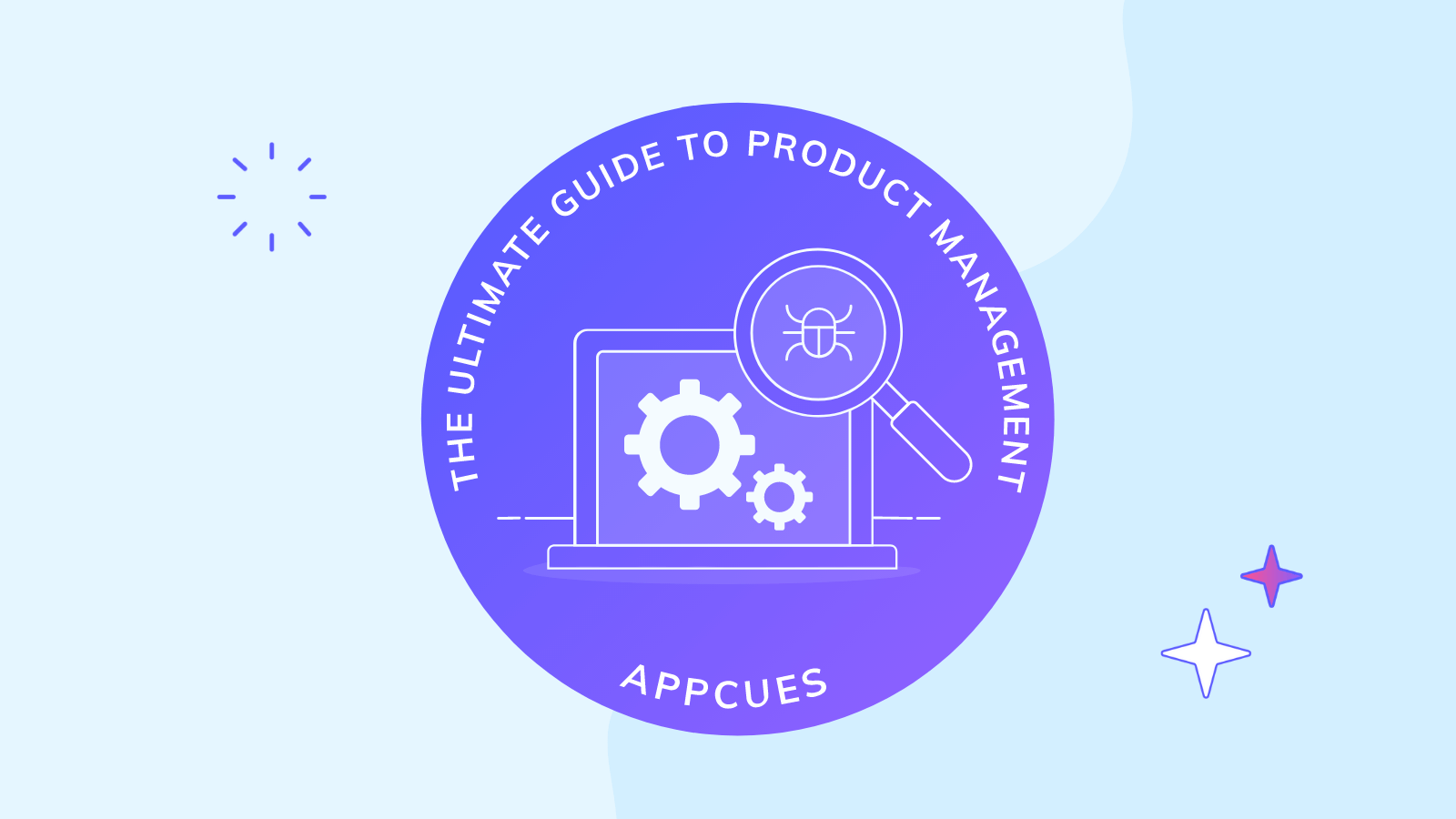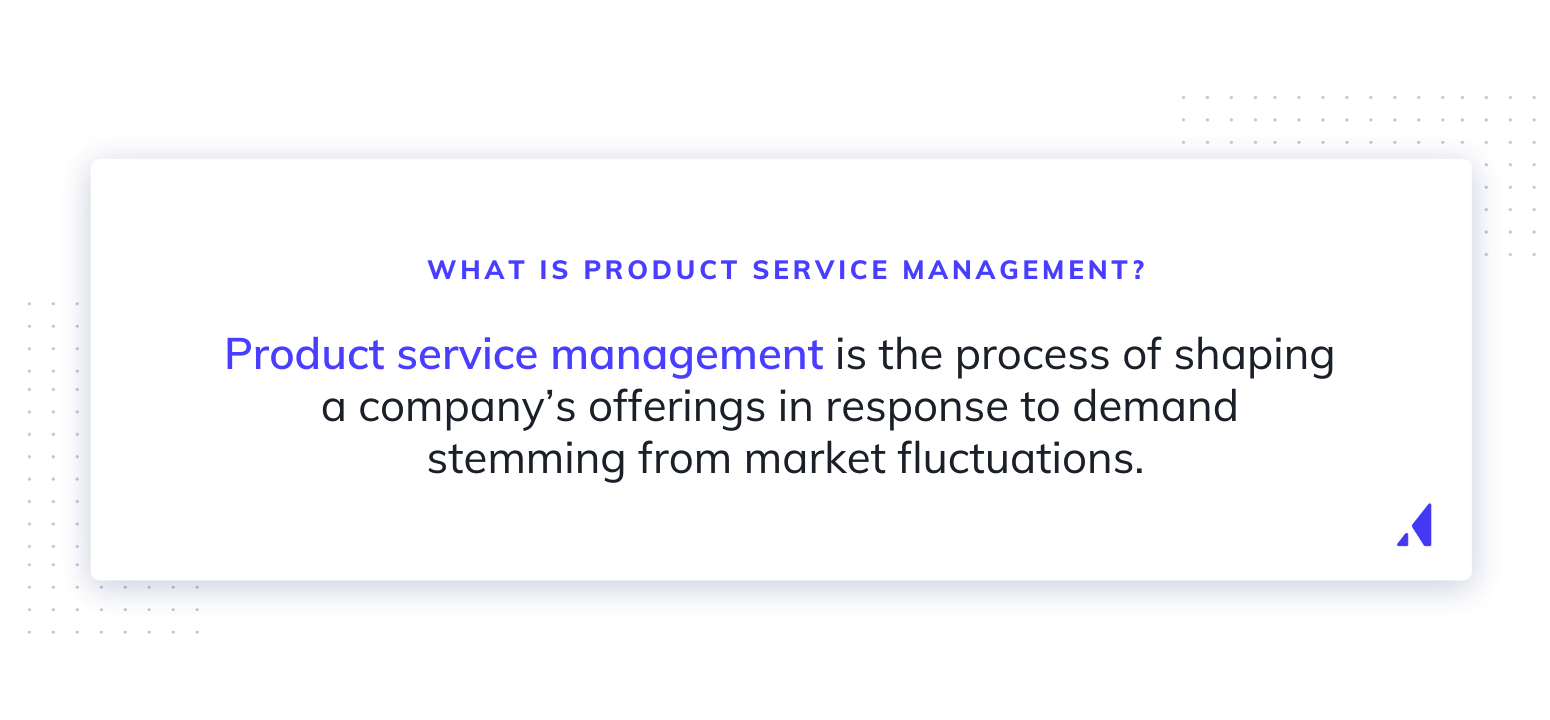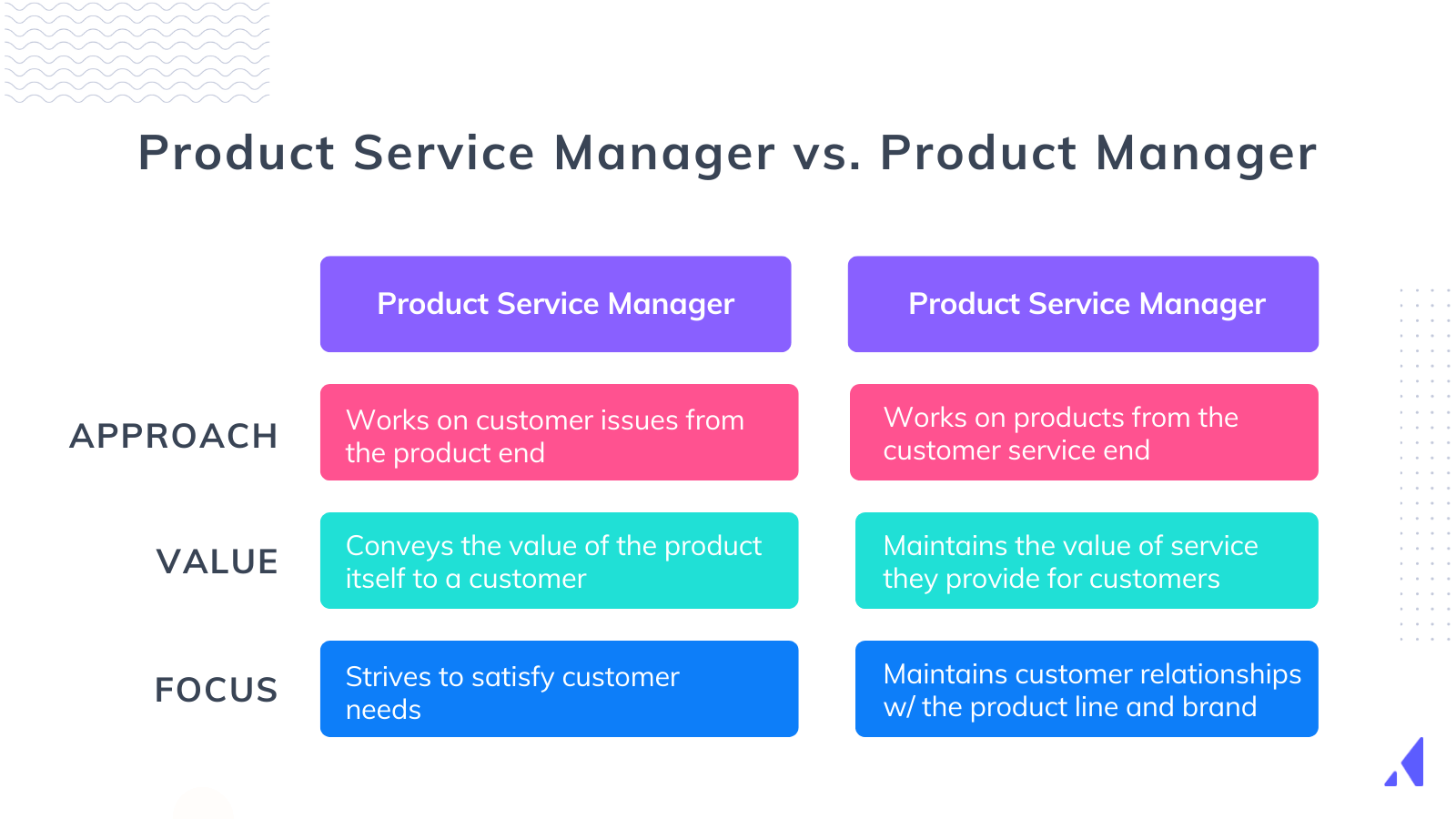Product Service Management Definition and Guide

.png)

.png)
SaaS tools are uniquely positioned as both products and services. Products are used, services are provided—and with SaaS products, users do both.
Most SaaS companies understand the importance of managing the development and growth of a product. (That's the product-part). But to truly make SaaS products that stick, businesses must anticipate customer needs and behaviors to keep customer satisfaction high during each part of a product's lifecycle. (That's the service-part).
Product service management (sometimes product/service management) is the process of shaping a company’s offerings in response to demand stemming from market fluctuations. A product service manager (PSM) anticipates customer needs and then guides product development to meet them. They ensure that customers’ experiences and satisfaction with a company’s entire product line remain high—even as products release, mature, and phase out.
This process bridges the gap between the concept of “software as a product” and “software as a service.” Many companies position their product service managers as brand managers to emphasize the importance of the marketing aspect of the position.

A product service manager’s responsibilities often overlap with that of traditional product managers (PMs) and marketers. Ultimately, PSMs are concerned with aligning product development with customer needs and UX (just like a product manager). However, they're involved in market analysis and marketing messaging (a la a marketer).
While product service management often bleeds into other roles, there are conceptual differences that distinguish it from traditional product management:

Product service managers obsess over the customer’s experience with a product from the moment they become aware of it to the moment they churn. This sweeping scope of work forces them to work collaboratively with product, sales, and marketing teams to align product development with current market trends and customer expectations.
On any given day, a PSM will:
You can’t make customers happy if you don’t know what they’re looking for. PSMs pull out all the stops to get inside their users’ heads. They have to find out what works and what doesn’t with their customer base. Feedback can be accrued in several ways:
Constant analysis of this data will help PSMs better understand their customers’ pain points and better inform future product and feature development and release.
Read more: How to collect and use product feedback to build better customer experiences
Even a product that creates a brand new market only stays competition-free for so long. A PSM must monitor what competitors are doing to ensure the company’s product line keeps up or stays ahead of alternatives. There are many factors PSMs need to pay attention to, but here's our shortlist for analyzing the competition:
Constant awareness of what’s working for rival products enables PSMs to remain agile in the face of increasing competition.
In a perfect world, new features would release in a bullish economic climate. In reality, even the best-planned release can run aground in economic downturns, sudden changes in customer preferences, and other drops in demand. Savvy PSMs carefully study their products’ various markets and economic trends to anticipate events that may impact future plans.
This is a PSM’s most important responsibility. Diligent PSMs absorb reams of information about a company’s customers, market, and competitors, but that information does a company no good if it remains siloed. PSMs must work with various teams within the company to ensure that feedback is implemented in a way that ensures customer satisfaction.
A PSM’s awareness of customer experience proves vital when it comes to product strategy, planning, and development. It’s crucial for them to be included in processes like product roadmap development to ensure that a finished product ultimately satisfies customer pain points. Additionally, a PSM’s involvement on the marketing side of things facilitates a more seamless product release between members of the product and marketing teams.
Read more: Setting roadmap priorities: What you need to know
.png)
In the fast-paced world of SaaS, companies float or sink depending on their ability to plan, innovate, and weather challenges. Proper product service management enables a company to do all three through:
Product service managers take on different responsibilities depending on which of the three phases a product or group of products is in. The three phases are:
In this phase, PSMs seek to answer two questions:
For PSMs, the development phase most closely resembles that of a product manager. The PSM performs customer, market, and competitive research and then discussed their findings and recommendations with the powers-that-be. They engage in brainstorming sessions where decision-makers consider whether certain ideas are plausible, marketable, and profitable.
As the product roadmap comes together, the PSM balances product development with the product team and product release tasks with the marketing team. The PSM stays apprised of roadblocks in product development and testing that could alter the release schedule and pivots accordingly. They also take relevant feedback from testing to shape marketing messaging and collateral accordingly–all while maintaining brand image, of course.
Once a product is released, a PSM’s responsibilities shift to gathering data and reporting their findings back to the product team. Marketing and product analytics are a PSM’s best friend during this phase, helping to identify which features users find engaging and which marketing channels they best respond to.
PSMs work closely in this phase to help the product team smooth out UX issues and minimize customer churn. They use product data and feedback to suggest changes that improve product adoption rates. PSMs also use this information to identify feature opportunities and potential new products.
While PSMs dive deep into how users interact with a product, they also manage the messaging, packaging, and methods behind this and other product offerings. When customer preferences shift or economic trends reverse, PSMs orchestrate new approaches to appealing to new and existing customers to maintain and grow their revenue stream.
A PSM’s job focuses on customer needs to facilitate a long and profitable lifecycle for their product. However, all good things must come to an end—and even the best products are phased out eventually.
Many product discontinuation decisions involve a lack of profitability that discourages further investment. Sometimes a market changes completely, eliminating demand for a particular service (think Blockbuster versus Netflix). Other times, companies completely change their product strategies in anticipation of market changes (think…well, Netflix again). Best case scenario: your product has simply outgrown itself. A new and revamped version is required to satisfy users and expand into new markets.
PSMs inform and manage the retirement of products. They work with executives to identify low-performing products or opportunities for growth that have rendered current offerings obsolete. Once termination has been confirmed, the PSM is charged with announcing the decision to existing users and managing end-of-life messaging through social channels, in-app messaging, and more.
Product service management has been a driving force behind the development of many famous products and features. It has also informed the product strategy of some of the biggest names in tech, including:
Companies can become too complacent when they achieve early success and domination in a particular market. Photo-focused Instagram proved popular with millennials and Gen Z in the 2010s. However, TikTok’s emergence in 2016 saw many avid Instagram users flock to the new platform as young social users abandoned static images for short-form videos.
Instagram allowed users to create short video clips, but their video options lacked the functionality of TikTok’s music- and copy-friendly platform. Instead of ceding the short-form video niche to a competitor, Instagram released its Instagram Reels feature in 2020 to compete directly with TikTok and prevent further shedding of young users. It’s impossible to tell how many users Instagram could have retained had they decided to compete directly in the four years between TikTok’s release and that of Reels.
Good PSMs have to temper the desire to improve product performance with the need to maintain good UX. They also need to be able to admit when they’ve made a mistake. The poor reception around Microsoft’s 2012 Windows 8 release is the stuff of legend. The release saw many changes to the platform’s UI, many of which users rejected wholesale. These big and controversial changes (like eliminating the Start menu) outshone many genuine improvements to the software.
Microsoft listened to users, releasing Windows 10 within two years. This version included product improvements while harkening back to the better-loved Windows 7 iteration—including its restoration of the coveted Start Menu.
Product service management is all about the customer experience. Dedicated product service managers need to use every tool at their disposal to gain insights from their customers and keep them engaged.
Appcues manages to do both. It enables you to create in-app messages to guide users seamlessly through your app, minimizing frustration and driving them straight to your product’s most valuable features. In-app messages can also announce new helpful features or create NPS surveys, so you never lose sight of what users think and how they feel about your product.
Best of all–you can use Appcues without writing a line of code, allowing you to focus on what matters most: dazzling customers with your products and creating loyal customers for the long run.